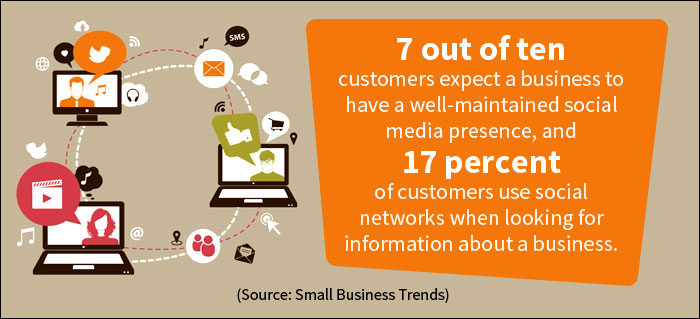4 Social Media Blunders Doctors Must Avoid
Posted on
Creating and maintaining a strong social media presence could be the difference between success and failure for your medical practice. The most popular platforms, including Facebook, Twitter and LinkedIn, are continually being transformed, bringing new features to end users. Healthcare marketers now have the ability to interact with patients, physicians, staff and hospitals presenting countless opportunities that did not exist 10 years ago.
From offering informational content to engaging patients, social networks have become so enmeshed in the fabric of healthcare that it is hard to imagine what it was like before they existed. Social networks’ impact as vehicles for communication and patient engagement has created a sea change in the way healthcare marketers communicate with their target audience. This is because social media is nothing but a digital form of word-of-mouth, and healthcare marketers taking advantage of social networks have noted the following common characteristics:
- Social networks can help you get in front of a huge audience. This is because far more people use social networks every day than read a newspaper or watch TV.
- Once something is published on social networks, it becomes part of the long-term strategy, which makes every post into an asset that can add enhance a practice’s online presence.
- Customers, especially millennials, are using social networks as an alternative to calling or emailing.
- Social networks are becoming the new preferred channels for customer service and engagement.
When a satisfied patient tells someone about an awesome experience at your practice, or your brand name pops into his or her mind when a family member or friend needs medical help, you are not just expanding your patient base or attracting potential patients. You are also getting the endorsement of one of your existing patients, leveraging a lot of trust into that relationship. You score a qualified lead who is far more likely to convert than a random visitor who hears about your practice through some other form of marketing.

The challenge in social media marketing is to use it effectively to grow your practice while avoiding mistakes that can result in a lot of wasted time and effort. Often, medical practice owners or healthcare marketers try to master social media marketing campaigns while juggling too many other responsibilities, or not knowing how to engage with their target audience.
In order to help ensure that your social media marketing efforts are effective, avoid the following mistakes:

1. Excessively Promoting Your Practice
This is probably the most common mistake most healthcare marketers make on social networks. They view it as a megaphone designed to shout out their promotional offers and accomplishments for the world to hear.
The most important aspect of social networks is that they are social. It is surprising how many healthcare marketers do not seem to understand this fundamental point. While paid ads and a website are acceptable ways to promote your practice to the world, social networks need to be about engaging and interacting with your target audience, not shouting at it.
There is nothing wrong with letting your followers know when something important is going on, such as a product launch, a special event or new deals. But if this is all you want to do on social media channels, then you may as well not bother. Not many people will be paying attention to your posts in the long run.
If you want to become part of the online conversations, it is important to add value, be polite and then casually mention your practice in the conversation. Not only does constantly promoting your practice and services turn people off to your business, it also saps all the power out of social networks’ ability to aid in self-promotion. The more you engage and educate your target audience, the more likely they are to pay attention when you do talk about yourself.

What we suggest:
Make it a priority to provide value to your target audience by engaging with them and actively participating in online conversations, not blasting them with your marketing messages.

Make an effort to understand your audience’s needs, and show interest by providing valuable information and answers to their questions. When someone leaves a comment, respond promptly. Make your followers feel heard and valued.
The biggest appeal of social networks is the human interaction it enables. If you are limiting your use of social media accounts to promoting your practice without taking the time to engage with your audience, you may never succeed in leveraging social networks to grow your practice.
2. Proceeding Without a Strategy
Like with most things marketing, having a clear strategy is critical. Because people are so comfortable with social networks in their personal lives, they make the mistake of jumping right into the most popular ones for their business without even a basic strategy for making it successful.
Social media marketing efforts cannot be successful without short-term and long-term strategies that address key elements such as customer persona, demographics, a content plan and an editorial calendar – all while allocating the resources to make those elements happen.
Cutting through marketing clutter, building a following, communicating with your target audience and increasing brand loyalty are some common social media objectives.
It is important to decide what your business objectives are and make them clear to everyone on your team. Then, direct all your resources toward achieving your goals.


What we suggest:
Develop a social media marketing strategy by focusing on your business goals, how you will research your target audience, the strategies you will implement and what metrics you will use to evaluate your progress.
Make sure there is one “single owner” of your social media marketing efforts. You must nominate a person who will ensure that there is a strategy in place, who will coordinate all efforts accordingly and report to management on the plan’s progress.
3. Spreading Yourself Too Thin
There are many social networking sites to choose from, and most healthcare marketers are tempted to think that the best strategy is to use all of them. The reverse is actually true. It is important to remember the social aspect of social media. If you are going to use a social networking site, you have to be engaged and post regularly. You cannot expect people to follow you if you do not make an effort – and an inactive account is worse than having no account at all.
Most healthcare marketers create accounts on networks like Facebook, LinkedIn, Twitter, YouTube and Instagram, and they find it very difficult to manage content creation for all those accounts. They are not able to utilize these platforms to their best advantage and do not see good results from any of them.
There is no need to create accounts on so many networks. Smart marketers only select the platforms that reach their target patients and devote themselves to creating sensible content that will work specifically for these platforms. There is a lot of demographic data available for each social network.
In addition, you must consider whether the network is suitable for your specialty and services. Think about the time and effort it takes to maintain an account on the platform. For instance, Twitter can be time-consuming. You also need to consider what other resources you will need to produce friendly content for that platform.


What we suggest:
Successfully understanding your target audience on even a single platform, building a base of followers, communicating with patients and using the channel to strengthen your brand requires extensive strategizing, planning and creative thinking.
Honestly, even having a full-time person dedicated to social media marketing may not be nearly enough to utilize more than one or two platforms effectively.
Instead of trying to be all things to all people, do some research about your target audience and learn which platforms they are most likely to use. There is no point in spending a lot of time on LinkedIn if few of your patients are there. Pick two, or at most three, social media channels that you think will yield you the highest returns.
4. Not Interacting With Followers
Social networks are changing the way medical practices communicate with their patients. Posting to a few selected social networks can help you stay connected to past patients, retain existing patients and attract potential ones. However, most of the target audience will not initiate a conversation with you if they do not have a reason to, or if they think they will be ignored. That is why it is important to post relevant content on a regular basis. In addition, if your patients are taking the initiative to leave a comment or ask a question, you must respond quickly.
Having thousands of followers who do not represent your target audience and have little to contribute will fail to produce desirable results. You want to attract and engage potential patients who share the same views and interests and who will be involved in the success of your marketing efforts. By building and nurturing your network, you will gain better access to potential and existing patients and will increase the exposure for your targeted messages.
It is also critical to make your interactions more meaningful! You should set aside time every day to reach out and write targeted posts, engage in online discussions and share content. Your social media posts are useless if no one cares to share or comment on them. Your posts and content should be designed to initiate conversations with your audience. If you do not get these reactions, your overall social media marketing strategy and content strategy should be revisited.

What we suggest
When you share content, boost a post or create an ad on social networks, you get a great deal of information about how your target audience sees and interacts with your content. If you want to improve patient engagement on social networks, you must use that information to help guide you going forward. If you notice that the videos you share on social media get twice as much engagement as other forms of content, it makes sense to reallocate funds so you can produce more video content.
The Wrap-Up
Of all of the things that social networks encompass, time-consuming ranks among the top! The average American spends 40 minutes per day just checking their personal Facebook feed! This is more time than they spend with their children. For a medical practice, a social media presence can be a time-devouring bottomless pit.
Our suggestion is, concentrate on doing what you do best and hire professionals to do what they do best. At some point in every practice’s growth, marketers reach a tipping point where they need to acknowledge the fact that, in order to continue to grow and flourish, it is time to outsource certain aspects. Often, marketing is one of the first. Be wise and follow the advice of others before you who have faced the same challenges. Focus on doing what you do best, and flourish.
Not all medical practitioners are social media experts in marketing their business online. Do you really have the time to get involved and be entirely effective? If you are not social media-savvy enough and your time is spent taking care of your patients, then it is best to hire social media marketing experts to handle your online presence and to help you grow your practice. Let Practice Builders help you! We can plan an effective social media marketing strategy to get potential patients interested in your practice! Contact a representative to learn more about our customized social media marketing packages.

 Why Good communication Matters in Healthcare
Why Good communication Matters in Healthcare De-Escalation Tips for Handling Aggressive Patient..
De-Escalation Tips for Handling Aggressive Patient.. Reaching The Right Audience Through Target Marketi..
Reaching The Right Audience Through Target Marketi..